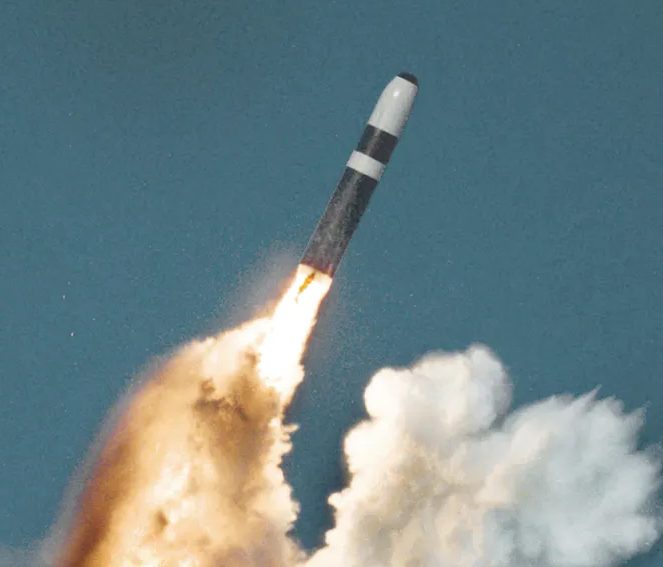The United States Navy is placing quite a bit of importance on the modernized Trident missiles to ensure their accuracy and reliability.
This will be done through continuous and rigorous testing.
The US Navy is in the transition from the Ohio-class to the Columbia-class ballistic missile submarines.
Vice Adm. Johnny Wolfe, who is the senior admiral directing the strategic systems program commented on the matter at an online forum of the Air Force Association’s Mitchell Institute.
“I have to keep that reliability for the next 60 years.” The incremental approach of modernizing electronics and guidance, for example, are the steps the military is taking “to get maximum life of all those things that won’t age out” over that time.
He said that the Trident D5 Extension Life II upgrade will start in 2021.
This is the second time the Trident D5 is being improved to extend its life. After the Trident D5 missiles underwent an original life extension effort (D5 LE), the office determined they would undergo a D5 LE2 effort that would insert new technologies where possible, find new ways to replace old parts that can no longer be manufactured, and otherwise keep the missiles reliable as a strategic deterrent for more than 60 years.
“We are starting this year – for the first time in our budget – we have a line in [Fiscal Year 2020], and the real crux to that is looking at all of those new technologies that we need to go think about on how we’re going to take what we have today, how we’re going to modernize it and how we’re going to get it to last the entire life of the Columbia, which is we all know about 2084,” SSP Director Vice Adm. Johnny Wolfe said back in November 2019.
In the January 2021 event, he made the following comment:
“From a missile perspective … we have to make sure that it is rock solid.” He called this “the big ticket for us” throughout the year.
Wolfe added, “as the Columbia platforms get out there [in the early 2030s], the weapons system will be proven.” He said the Navy will be buying an additional 108 missiles for its inventory to be used for deployment and testing.
The Trident D5 is armed with an W93 Mark 7 warhead, that’s also being improved.
Wolfe said that “we need to start the investment” and examine the technology now to stay ahead of potential threats.
The National Nuclear Security Administration, a semi-autonomous body in the Department of Energy, is a key player in weapons modernization and the development of propulsion systems.
Its investment philosophy was heavily scrutinized in US Congress. The Agency had to explain why it carries over approximately $8 billion in unspent funds year-over-year that lawmakers argued could be put toward building a second Virginia-class submarine in 2021.
In September 2020, testifying before the Senate Armed Services Committee, NNSA Administrator Lisa Gordon-Hagerty defended her agency’s carry-over, saying “it’s obligated for this five-year spending plan” that includes rebuilding nuclear infrastructure at its laboratories and plants, treaty compliance, nuclear non-proliferation programs and modernizing four nuclear weapons systems.
Back in that same hearing, Adm. Charles Richard, head of U.S. Strategic Command, added that instead of slipping timelines for the submarine or any other strategic modernization and recapitalization project, he’s asking “what’s it going to take to have those programs come in on time.”
As such, Wolfe considers it more likely that a non-nuclear warhead would be produced.
“My money goes to all the non-nuclear,” Wolfe added.
The US Navy will also have fewer Columbia-class submarines, than the Ohio-class – 12, not 14.
Wolfe said that wasn’t necessarily a bad thing, he said, “time offline will be less” for maintenance, such as the two to three years needed for mid-life refueling now. That translates into more time on patrol, rather than in the shipyard.
Wolfe said the replacement for the Ohio–class ballistic missile submarines remains “the Navy’s no. 1 [spending] priority.”
To keep spending under control, he said the Navy has learned much from the Virginia-class and its modernized payload, as well as adopting mature design concepts into planning.
In the strategic systems program, “we built strategic weapons ashore” facilities for advanced prototyping and testing for both the Ohio and Columbia-class platforms to assist the transition.
This entire transition is being done at the same pace the United Kingdom is transitioning from its Vanguard-class ballistic missile submarines to Dreadnought.
Wolfe said that an Analysis of Alternatives for a sea-launched nuclear cruise missile will be finished in 2021, and the design could start the next year.
He said, “if you have a sea-launched cruise missile it changes [potential adversaries’] calculations” about a possible attack. “I think we’re raising the threshold” of deterrence by pursuing this.
He cited Russia’s deployment of tactical nuclear weapons on cruise missiles on its borders and its doctrine of “escalate to de-escalate” as the threat to be deterred.
Wolfe noted that “Russia certainly has a triad” of nuclear deterrent forces, and “China is on its way to a triad.”
Finally, for the United States, the triad of sea-based ballistic missiles, land-based ballistic missiles and bombers “are the right way to go.”
The combination affects potential adversaries’ “thought calculus” because “you can’t just go after one thing,” even on land-based systems because they have different ranges and targeting.
MORE ON THE TOPIC:






